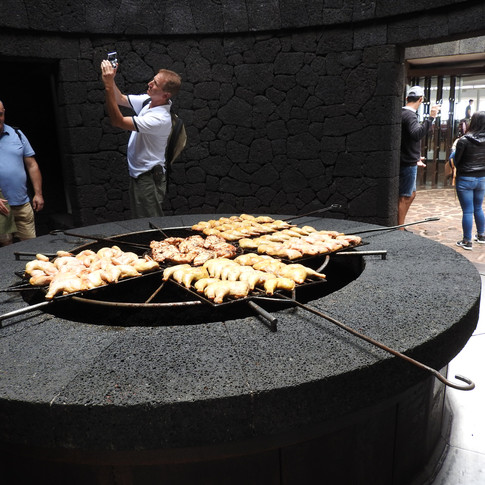8. Canary Islands
- Chris
- Feb 19, 2019
- 16 min read
After we weathered the storm in Tanger Bay Marina without any damage apart from a flue that passed to every crew member. Yes also the wind generator was still attached to the mizzen mast, we set sails again to catch the forecasted winds towards south-west, the Canary Islands. At first we had the idea to visit Marocco by train a few days, but with that cold, windy and rainy weather we took the first opportunity to go south.
The weather was good on 1st November, the clearing out was easy going, the man from the border police even brought our drone back to our ship! We knew the start will be quite bumpy, with high waves from the last days and a wind turning from West to North West during the day. As always, we could rely on our MWM motor from Mannheim, strong as a German tank, for the first 2 hours, until we set our 3 standard sails, Genoa, Main and Mizzen and headed 210 degrees.
The trip to Lanzarote was unspectacular to be honest, most of the time we sailed in cloudy weather but with a very steady breeze from North. Our logbook contains hardly any encouraging entry, German sailors call it “Meilenfressen”, eating mile after mile, nearly 600 until Puerto Calero in the south of the island. Unfortunately our Gennaker broke again. This time on the top, and we did not try to fix it like the last time. On the first 2 days, everyone was suffering of seasickness, some worse, some just a bit, the rolling of the sea is something hardly anyone’s stomach is resisting, fortunately there are nice pills which make lives a bit easier. But the main issue we were facing was a technical one, our batteries! Their load did decrease very fast although we are now equipped with not only solar panels, but also a brand-new wind generator, how come? The winds from aft where ok to sail, but not enough to load our batteries, and as mentioned above, we had many clouds which hindered the sun to burn on our roof, so not much from the solar side neither… As a consequence, we started the motor when the wind was a bit weaker and charged it like that, so our batteries survived the 6-days trip. On day 5, we did something nobody of us ever did, the first time in our life we called someone from a satellite phone, it was the marina in Puerto Calero, where we reserved a berth for 2 nights. We arrived in this well managed place at lunch time on 7 November 2018, lovely sunshine and a friendly marinero welcomed us on Spanish territory again.
Lanzarote
What a super-touristic island this is, I believe at least half of the cars on the streets belong to rental car companies. Main attraction is the Timanfaya volcano, a spectacular lunar landscape and on its top a restaurant that can actually do BBQ with the hot air coming out of the volcano, very cool! The main colour of the island is black, there is hardly any vegetation. The nearly 200 years since the last eruptions of the volcano was not long enough for nature to recover. Many wine makers grow grapes on the black and stony soil, because of the steady winds, the plants are somehow semi-buried in small roofless castles in the shape of a horse shoe. Nice to see such effort, the wine unfortunately does not taste very good, at least not the ones we tried in 2 of the many wine tasting shops along the streets. Of course, there must be an exception to the rule, in the restaurant we had lunch the same day we were drinking a stunning rosé, made in Lanzarote! We tried in all the different shops to find this exact wine again, but finally had to leave the island without it.
But of course, our island trip was not meant to be a wine seminar, we did what we like best, driving around, watching out for nice landscapes, playgrounds, exotic animals and from time to time an ice-cream seller. One day we took the public bus and had a ride to the main city, Arecife, interesting in many aspects. The bus was quite expensive, especially compared to quite cheap car rentals or taxis. Every road is in perfect condition, and this is as well true when traveling to the less crowded north. The south of the island is an accumulation of retort cities or resorts once built up in the 80s or 90s of the last century, most of them just ugly. The nearer you get to the main city, the more it looked like in every other suburban area in Europe, motorways, shops along them, an airport there, a bus terminal here, and at last, the city, which looked like needing soon some fresh blood in order to survive. The Canary Islands as such are populated by many more Non-Canarians than originals. There are notably many Germans and Brits on Lanzarote, at least one radio channel is in their languages.
On 10 November we continued our journey towards the south, Punta Papagayo was our goal. The winds pushed us perfectly well, hardly any waves because the wind came from the land. After just two and a half hours we dropped the anchor and 35 meters of chain in the clear water. We must say, as much as we like to be ashore after longer sailing trips, the best feeling we still have, is when anchoring in the wild nature, that’s real sailors’ life. The beaches there are fantastic, Playa del Pozo was the one in front of us, it is a naturist beach, but nobody cares if you still wear something. The kids had sooooo much fun in the nice sand and the parents did some snorkelling. What we already knew, but only realized when actually diving in, the water is cooooold, hardly 21°C! Even if much more south, the Atlantic is not comparable with the Mediterranean during summertime, where we last swam in near 30 degrees (boiling) water and could stay in for almost ever.
Fuerteventura
After 2 days in that nice bay in the extreme south of Lanzarote we were forced to leave that nice little paradise again. We expected some strong north-westerlies which would have made our ship dangling around much more, which is annoying after some hours. We did not have any ship around us, and the bay did not cause any difficulties to get out, a good opportunity to once do everything manually, so without machine aid. Normally you switch on the main motor, and you wind the anchor up with the anchor winch, just pushing a button. We first set the mizzen and the main sail, then winching up the anchor, hard work but some exercise is good from time to time. As soon as we turned into the right direction we as well set the yankee, the sail in the front of the ship. Winds were not strong this morning, but enough to sail comfortably towards Fuerteventura, so south again. After some hours, winds were weakening more and more, where were these north-westerlies hiding?! The same time we already wanted to switch on the motor, our depth meter did suddenly show us 1.5m only. Could not be, like this our keel would have already hit ground, and the island was quite far away, so there was something wrong on the technical side. In the meantime, the wind completely stopped, our Jolly just moved southwards because of the current. Christoph did take this opportunity for a quick swim and dived to check the depth meter next to our keel in just about 1m depth. It became a short swim because of two reasons. First, he could not reckon anything wrong with the depth meter, he gently brushed it, the “plug” was nicely fit into the hull, nothing wrong. Second, soon after he dived in, there was some wind coming up, all of a sudden, we had 3 beaufort from NE, better get on the boat again before it sails away without him! The rest of the journey along the eastern coast of Fuerteventura became a really cool sailing experience, the winds accelerated to a nice 5 straight from behind. The waves pushed us towards our next port, Gran Tarajal, together with the current our Jolly reached 7-8 knots. Unfortunately, we arrived quite a bit after sunset, in complete darkness, but the harbour’s lights showed us the right path. As we could not reach anyone from the marina via VHF, we did not quite know where to go, but some nice Swiss crew of a German boat showed us where to install ourselves.
The other morning Alina checked us in at the harbours office for 2 nights, this was as well how long we stayed in the end. This island we have only seen from water, meaning we did not really visit it, another desert island, this time in brownish colours did not encourage us to stay any longer. Still we enjoyed the time in this little town, especially Dalia had a great time, as she could play with the kids of the neighbour boat. An Italian family with a boy and a girl, living on their aluminium ship about 10-11 months of the year, and this already for more than 5 years now. They were just leaving to get “home” again the day after we left, otherwise we may have stayed a bit longer on Fuerteventura as well.
Gran Canaria
Starting at 10am on 14 November, we already knew that we will sail overnight, to arrive in the south of Gran Canaria the next morning. The first 2 hours we run under engine, we had first to move out of the “wind shadow” of the high mountains there, but just after noon we where hit by a nice 4 beaufort northerly helping us towards west. During the calm and sunny start, we had the best places to follow a military exercise of the Spanish marines. 2 big war ships and several helicopters where engaged, luckily nobody fired anything at us!
Some hours later we reached the south-western end of Fuerteventura, the winds did not change, but we obviously got out of the islands’ protection against the waves, so the trip became a bit “sportier”. Compared to 2 days ago when the waves pushed us towards south, this time our course was 260 degrees, so it did not help us at all, instead we were shaking much more than we wanted. Still our Jolly fought itself with nice 4 to 7 knots over ground nearer and nearer to the south of Gran Canaria. In the middle of the night the nice winds stopped and we started the motor again to help, at a quarter to 8 we arrived at Puerto Rico Marina. The marina office opened some minutes later, perfect timing, and they even had a nice space for us at pier number 7.
May some of the less experienced sailors ask themselves why we did not sail to Las Palmas, the capital in the north of the island, where we had found better “sailing” infrastructure than in the south of the island?! There are 2 reasons, first, we could not really sail much more north that night anyway, with the northern winds and the waves we could only sail to the south of the island. But second and much more important, we would not have found neither a berth nor an anchor opportunity up there anyway. The entire November you should avoid Las Palmas Marina, unless you are registered to the Atlantic Race for Cruisers, ARC, usually starting as of mid-November. More than 200 yachts in several lengths and shapes start to the Caribbean during that period, and this is only the official number. Many more yachties take this opportunity to start around the same days, to kind of convoy them, not to be too alone on the big Ocean.
We had other things in mind, of course we wanted to visit the island, and as nearly always we had some things to fix on our boat. Every ship is a moving repair centre, at least up to a certain extent, the perfect sailing ship where nothing breaks still has to be invented! Main issue was that we still carried the (again) torn gennaker with us, so this needs to be repaired, and we wanted to find a second one for backup. Puerto Rico does not offer anything unless a well-run marina with nice facilities, so we soon knew that we had to get to Las Palmas sooner or later to buy certain sailing equipment. So, we rented a car and got there one day, also to see what is going on around the ARC. Maybe we did not pick the right day, but really more than an overcrowded marina was not there. The ship chandlers have all been super-busy, but they were as well staffed accordingly, we met some very experienced sailors there with tips and tricks for the upcoming crossing. All in all a very successful day, Dani did take care of the kids and Alina and Christoph did some shopping for Jolly Jumper.
The other days we had that nice Peugeot Partner we cruised around the island and visited some nice places in the middle of the island. Some valleys there reminded us of the “Wild” West of the United States, deep canyons with nice shapes and colours, just more compact than on the other side of the Ocean. After some 15 minutes of driving you find yourself in the mountains or the woods, with hardly any signs of civilization, just the well-maintained roads remind you that of course this is a very touristic island, too. Still, compared to the other islands of the Canaries you actually have a lot of real residents there, especially in the north you find many more Canarians than tourists. Around Las Palmas you find quite some industrial plants, distribution centres and so on, in the south you find some plantations of banana.
Puerto Rico is the exact opposite, there is no other than touristic infrastructure there, this town is populated by long-term tourists from the Nordics. One can understand them wanting to bridge the cold and dark season, but why the hell do they still have to drink that much?! Many we have seen did not make it until noon to being drunk again, the rest did make it until 3pm latest. Perfect for us, after Alexa’s siesta we could go on the near-empty beach. I said earlier that we could not find anything for our boat there, but we got in touch with Violeta, a sail/paragliding repairer, she picked up our Gennaker directly from our ship and made it stronger again! She even offered us a second-hand Gennaker for 300 Euros, but this is another story we will tell you later.
Tenerife
We left Puerto Rico just the four of us as Dani was spending a week “country-holiday” on Tenerife. Our destination was also Tenerife, but a nice quiet bay on the eastern coast. We spent some very relaxing family days anchoring in different bays moving south in small steps. Our duties were fishing, swimming, playing on the beach and visiting playgrounds at land. After ten days we met with Daniel again in Puerto Galletas, the most southern point of Tenerife. It is a great place to start day trips to visit the island. Also you find different landscapes in the south and the north, but in our opinion Tenerife is nice, south and north. On Tenerife you can go up on top of the highest mountain of Spain, El Teide. This is the main attraction in the region and as expected a must-do for every tourist. The landscape around the mountain cannot be defined as beautiful, it is rather interesting. As a Swiss, we are used to mountains with at least some vegetation or snow. The Teide is sometimes white on the top, but the rest is grey/brown with little brown plants and so are the valleys around. Our plan was to go up on top with the cable car, but as we arrived at the station and saw the full parking, the long queue of tourists and finally the peacefully sleeping girls in the back of the car, we decided to pass by. We then stopped later for a nice hike with an astonishing view over the island. But take care, as soon as the sun disappears behind huge Teide peak it becomes freezingly cold, when we got back to our car, we only had 6°C…
Another trip we really liked was the visit of a banana farm. The… is a family run estate since … As the island is actually full of stones with very little vegetation, during many years they brought earth from the island of La Palma. Then they started growing bananas, and as we learnt there are many different kinds of. Still being in family hands the ranch can be visited for only €5 per head, kids for free. We have learnt a lot about how to grow and harvest bananas and that at the end the marked decides the price you get, which in any way is too little in our opinion. At the end of the visit we were invited to taste different products made of bananas. All very good, but only a bottle of banana wine and vinegar were later stored in our ship, the vinegar is soooo tasty!
Our next sailing destination was Spaghetti Bay. We were attracted by the name, but in the end, it did not have a lot to offer, at least not for No-Hippies, No-Naturists and party folks like we are as a family… So, we continued the other day towards the north of the island. Los Gigantes are huge cliffs where you can sail along some meters away from without any risks, still it is somehow frightening! Again, we anchored a little bit north of the cliffs, to then head towards the beautiful Gomera island the day after.
Starting early that 3rd December we could not know that it will not only be a daytrip, but let us start from the beginning: Soon after we motored out of the lee of Tenerife island we were hit by a quite strong southerly wind, more south than we would have liked, but manageable because the waves do only build up later. Still we had to be sure to find a safe harbour on Gomera, so we called the marina and asked for a berth. The response was not very encouraging, they could not tell, we should call again before lunch. In the meantime, our Jolly fought itself as south as possible, but we soon had to admit, that we may better head to an anchor bay in the north of the island. We arrived around noon and called again to check for a berth for the day after, but the answer was even less encouraging than during our first call earlier in the morning. They could not tell if there is anything free for the next days, but we should call later in the afternoon… We knew that due to a wind change we could only stay for one night in the bay north of the island, after that we would have to move to the west coast. But also there we would be able to anchor only for one night before wind and waves would make anchoring impossible on this side of the island too. We discussed during lunch, and all of us said “no way”, so we decided to leave immediately and sailed to Las Palmas, Gran Canaria. The hours until dusk we could sail perfectly, then the wind weakened, turned to an easterly, so we motored against until the next afternoon, arriving in the capital.
Gran Canaria the second
The harbours regime in Las Palmas is quite special, you should go anchoring and then call their office over VHF, providing all the specs of your ship and an approximate length of your stay. They then call you again when they are ready to receive you. Sounds very fair and reduces the mess they may got when everyone arriving just enters the marina and checks in at the welcome pier. Unfortunately, nobody called us, so we called them again and asked if we could still enter by daylight. Their answer was that they tried to reach us, but nobody answered, strange but what do you want to say, could have happened. We had to wait until the other morning, but this time we did not call them on VHF this time, we went directly to the welcome pier, and checked in at their office. They were saying that the marina was full, but all of a sudden, when our girls accompanied Alina to the counter, they found something, kids bonus, hurray!
We stayed at the marina for quite some time, again many tasks on our list: hunt for Dometic spare parts for our oven, stocking up at the ship chandler, receiving back our Gennaker, having our motor checked, seeking for playgrounds with the kids, doing a loooooot of food shopping.
During our first visit in Las Palmas we tried to order spare part for our kitchen via the ship chandler, they even had a login to the resellers page. But they could not get a proper answer from them, really disappointing. Crazy but no joke, we found a reseller in Switzerland, Wirth Camping in Frauenfeld. They shipped everything to Dani’s brother Reto before Christmas, and he brought it to the Cape Verde Islands beginning of January…
Violeta the sail repairer showed up one afternoon, it was already dark, nevertheless she, respectively her boyfriend carried 2 blue sail bags. One with our repaired sail, the other with a repaired one another client has forgotten about. Christoph checked the 2 sails, our weak Gennaker looked strengthened in the corners, so issue solved. The other one’s tissue was much thicker, but still it was easy to pull it up the mast on his own, otherwise it looked fine, of course it was old but for €300 you do not expect something new, right?! The day we sailed away, heading to the Cape Verdes we obviously wanted to test it right away, only 10 minutes when there was a loud scraaaaaatch and it was torn right in the middle! So much for a “new” sail!
In the Sailors Bar in the marina, where we crossed quite often and ate lunch or had a beer, we also got in touch with another member of our beloved Swiss Confederation, Karim. We “knew” him already from some flyers (every free corner in the marina and bars are full of flyers of people seeking for an engagement as crew for an atlantic passage) you see here and there, but did I say WE got in touch with him? Dalia got in touch with him, when she finished her pasta she started playing and soon involving him because she learnt that he spoke Italian. Some minutes later she was already sitting on his knees! We know that our bigger daughter is not really shy, but this was more than usual and it made us think… Why not taking one more crew member on our ship, place can be made, and the nights become so much easier when you are 3 instead of 2 people for the watch?! Some days later he was moving into our floating home, joining us for the 700+ miles to Sal Island, Cape Verde.
Karim also provided us with the contact of Laurent, a French ex-Militaire. He spent many years of his life in the Caribbean, he knew what we and our ship should expect over there in terms of heat, humidity, sun rays, sandy air etc. He also knows dealing with motors, and he was delighted to find such a beast as ours hidden under the cockpit. Christoph and him discussed quite some time what to take care of, then tried to find the impeller, and finally found and exchanged it. Other than that, there was not much to do, a next maintenance is only due after some 100 more motor hours.
Food shopping was very important in Las Palmas, we did not quite know what to expect on the Cape Verde Islands, our books were saying, that you should buy all the essential things in Las Palmas. And it became true, it is Africa down there, especially when you arrive in Palmeira on Sal Island.
In Las Palmas we became friends with a Polish couple living on their boat with their two lovely daughters. Dalia spend many afternoons playing with the girls either on their or on our boat. They live in Las Palmas for a few years now and the girls speak perfectly Polish and Spanish as they attend the local school. Before leaving we even received a bag full of clothes for Dalia, as the girls were slightly older than her. Sadly, in Las Palmas we have to count a loss… Alexa managed to sink the children’s kickboard. Our very nice Spanish ship neighbour even went down diving for it at 11m depth, but he couldn’t find it anymore. In Las Palmas we also met again with a family from New Zealand we knew from La Linea and they were already leaving for the Caribbean. To us the Atlantic passage was still very far away.
On 13 December after lunch we left Europe again, this time for longer. We stopped at the fuel station to make some Diesel. Christoph could not believe that we consumed over 600 l since Lipari, but it obviously was true and counting up the hours it totally made sense. Luckily gas prices are ridiculously low, at least compared to Swiss prices, not even €1 per liter. Then we had to round a small cape on Gran Canaria to then head 220 degrees straight to the Cape Verde Islands!





















































































Comments